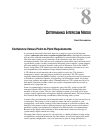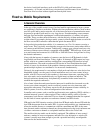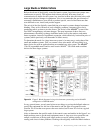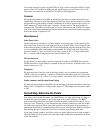
118 Handbook of Intercom Systems Engineering
We briefly touched upon the primary forms of communication used in television
broadcast. These are PL, IFB, ISO, and PP, with the first two (PL and IFB) being the most
important in order to produce a television program such as the news. Let’s take the
example of the medium size system and specify first a two-wire intercom and later a four-
wire intercom. The positional needs for our example medium studio intercom are shown in
Table 8.1.
Two-wire Case (Medium Intercom)
In Figure 3, we show a drawing of our proposed two-wire medium studio system. A
medium mobile vehicle would be similarly equipped. It demonstrates both PL and IFB
forms of communication.
803-G1G5 Master Station
In this example, we are using what we call the TW approach. Historically, TW is an
acronym for two-wire, and has been used with reference to an RTS™ PL (conference or
Party-Line) system for almost 25 years. We have used the model 803-G1G5 two-wire
master stations for the more important intercom stations in the control room. This unit
allows the operators to access up to six conference circuits in any combination with the
additional ability to selectively listen without talking to all, some, or none of them.
Because of the 8-channel IFB requirement, the 803 stations have been fitted with the
G1G5 option. This option effectively moves stand-alone Model 4002 8-channel IFB
control panel into the 803 itself, a compact, space saving feature. This G1G5 option is a
high-end IFB system providing both tally and override with other control stations. Two
rack units are all that is required for the full-featured 803 Master Station.
Table 8.1
An example of the positional needs for a typical medium sized intercom.
Director Producer Audio Video
Technical Director Tape 1 Tape 2 Tape 3
Chyron 1 Chyron 2 Camera 1 Camera 2
Camera 3 Camera 4 Camera 5 Camera 6
Teleprompter Floor Director Roof Access Telco
Talent 1 Talent 2 Talent 3 Talent 4
Talent 5 Talent 6 Talent 7 Talent 8


















